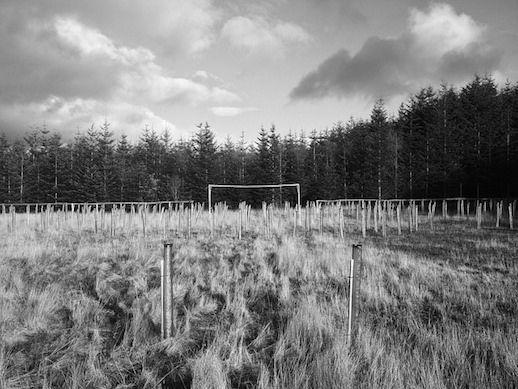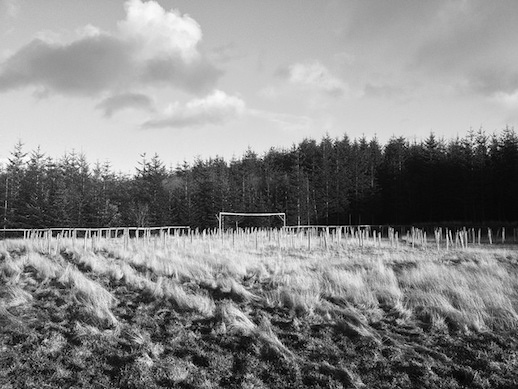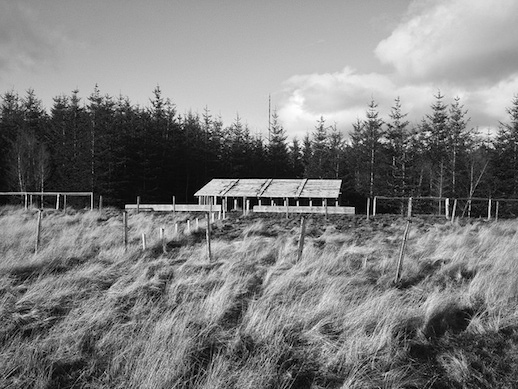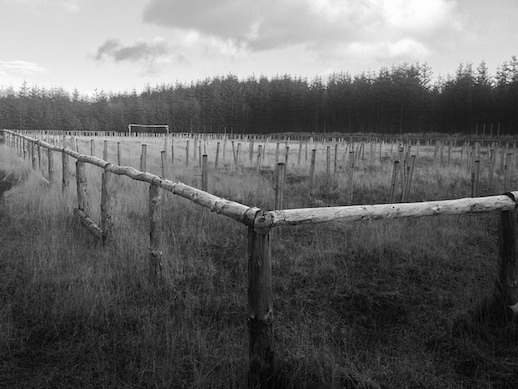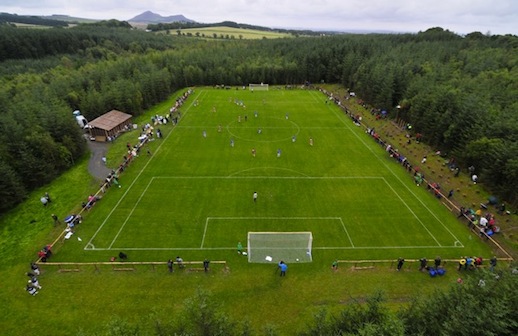Words and pictures by Rob St. John
Somewhere, perhaps in southern Scotland, there’s a commemorative cup designed by Sir Walter Scott and given to the winners of a game of football played in the Borders in the midwinter of 1815. The match, known as the Carterhaugh ba’, lasted over five hours, and took place over a pitch almost a mile long. Each team numbered over one hundred men: on one side a team of shepherds and farmers led by the Duke of Buccleuch; on the other a collection of men from nearby Hawick, Selkirk and Galashiels. The match was steeped in the landscape: goalposts were marked along stretches of the Ettrick and Yarrow rivers; the Duke’s team wore a sprig of heather, the other a sprig of pine.
Scott, an important architect in the construction of how we imagine Scottish identity and landscape, attended the match alongside 2,000 other spectators. Ceremony and pomp was rife: the Scottish war banner was unveiled for the first time in 200 years and bagpipes played martial tunes. According to Alastair Moffat’s book The Borders, the Duke’s heather clad team were losing at half time, and Scott was sent to convince the Galashiels men to defect and play for the Duke, which they did, reversing the deficit at full time, and making Scott an unpopular man in Selkirk. Scott’s ceremonial cup remains AWOL.
The match took place at point in Scotland’s history when the rural landscape was changing significantly: the Highland Clearances were depopulating the upland glens, and the increase in sheep farming, deer numbers and deforestation opening up wide swathes of empty, treeless land. Nearly 200 years later, Edinburgh artist Craig Coulthard staged two games of football on a pitch not far from the site of the Carterhaugh ba’ on land belonging to the current Duke of Buccleuch. The ‘Forest Pitch’ was created from a clearcut of commercial spruce forest, the pitch marked out on a seemingly blank canvas of land revealed from underneath the plantation canopy: formal lines over formal lines.
Two games of football between recent British citizens were played on the Forest Pitch in August 2012 as part of the Cultural Olympiad: tangling lines of cultural and ecological diversity in the space opened within the monoculture forest. Like the Carterhaugh ba’, the Forest Pitch matches took place in a context of social and environmental change, as debates over Scottish independence, self-determination, and the form and function of the rural landscape (significantly, perhaps, in terms of reforestation of native woodland and extinct animals) continue to swell.
After the matches, the site was largely left to return to the whims of nature, the tangents and trajectories of renewal and regrowth open for decades to come. I have followed Forest Pitch almost from conception, having numerous conversations with Craig throughout the project, and a visit to the newly felled site in early 2012, which I wrote about in the exhibition book. I have also defended the work on several occasions against accusations over the land and funding being essentially misused as the pitch is allowed to return to a ‘wild’, unmanaged state.
I revisited the site at the beginning of February 2014 to take the photographs in this piece. I’m interested in this piece of work as a rare proving ground for watching how the landscape responds to abandonment, and the tied attitudes that people attach to this process of change. On this visit, the pitch was punctuated with hummocks of thick grass and the first plant colonisers creeping below this tufty micro-canopy. Fragile young saplings of local, ‘native’ tree species traced curved and straight courses along the pitch’s former markings: planned order within the planned wildness.
Below is an extract of my piece in the Forest Pitch book, available soon from the website. I’m planning to revisit the site regularly to document its development, which I’ll write about on Caught by the River over the coming months.
—
Uncertain Memory: the landscape of Forest Pitch
On a site visit to the Forest Pitch in late May 2012, Craig Coulthard and I picked our way through the tangled spruce forest, flecked with drops of remnant rain from an ever-shifting sky. Clouds scudded across the low Borders hills as if caught in a painter’s brush-water. We listened to song thrushes improvise tunes to each other through trees, the sound tumbling through gaps in the forest into a flare of spring sunlight on yellow gorse. A tawny owl stopped to watch us awhile before quietly sweeping away like a ghost through the canopy. A beautiful place: did it matter that this was an entirely artificial forest, created less than 20 years before?
I initially thought of Forest Pitch in polarised terms: as creating a beacon of ‘native’ diversity (both human and ecological) within a sea of homogenous, dense and ‘non-native’ forest. Craig had talked about wanting to find a dark, claustrophobic monoculture woodland through which to cut the Forest Pitch: one that drew overt lines between dark and light, black and white, open and closed canopy. An open canopy lets in the light, encouraging ecological diversity and growth, and the clear-cut Forest Pitch provides a similar service – however fleeting and ephemeral – to cultural diversity. However, after a series of failed advances onto potential sites, the Clarilawmuir plot was chosen. The low, relatively sparse spruce trees are less dense and foreboding than on many other Scottish commercial plantations, and are fringed by mature deciduous woodland pockmarked by bright gorse and hawthorn.
In many ways, this deviation from the original intention of polarised ‘nativity’ makes the project more interesting. The borders between native and non-native; natural and artificial; open and closed canopy are certainly hard to pin down at the site. Where does the ‘artificial’ forest end and the ‘natural’ forest begin? How does our experience of walking through the woods differ through these different zones?
Ideas of what is ‘natural’ or ‘native’ in terms of cultural history or heritage – or that of the environments that surround us – are usually inherently political and charged with emotion. Ecologically, populations of humans, plants and animals have shifted so dramatically (and often unpredictably) in the past that attempting to pick a time period when an ecosystem was made up of ‘native’ populations is largely arbitrary and unhelpful. With the realisation that populations have never stayed still – and probably never will – the task of defining nativity becomes more complex. Scotland no longer harbours wolves (the last of which was shot in the 17th century), but neither does it support woolly mammoths or aurochs, both of which survived the tundra environments of Pleistocene Scotland. Which animals are ‘native’ to Scotland?
The little owl – a close relative of the tawny owl seen on our site visit – is common to England, Wales and southern Scotland and largely regarded as a species native to Britain. However, in reality it is a non-native species, introduced in the 19th century and ‘naturalised’ in popular culture. In other words, the process of defining a ‘native’ species or ecosystem often relies on social choice and construction.
Definitions are increasingly important, as the concepts of ‘natural and ‘native’ ecosystems, plants and animals largely underpin decision making in modern environmental management. However, this definition process is heavily influenced by our own social constructions, priorities and narratives, and is as such frequently open to debate. Both practically and conceptually, to fully plan and plant a “restored” ecosystem towards some desired state (whether from a past or current analogue, or one that is imagined) is likely to be impractical – veering perilously close to the management approach of the ‘artificial’ monoculture woodlands bemoaned by many.
The blurred topographies of ‘what is native?’ and ‘what is natural?’ picked over here sit squarely within the centre of current thinking on environmental restoration, and Forest Pitch provides a new and valuable set of challenging perspectives to this debate. Forest Pitch is a productive landscape in a multitude of senses. It opens up new spaces (both literal and metaphorical) in which to view, use and think about the landscape, the form it should take, and how it should be used. It is a public piece of landscape art, which through its borderlines between what is planned, natural, intended or otherwise in its development and use, encourages an immersive, emotion-led interaction from visitors. It becomes an important and thought provoking ecological site to be visited, a world away from the limited set of visitor boards, ‘biodiversity trails’, and endless other creeping rules and regulations that govern many of our modern interactions with nature.
Fundamentally, this is a project about boundaries: between the wild and the domesticated; the predictable and the uncertain; the diverse and the homogenous; the native and the non-native; between traditional uses of the Borders landscape and ambitious upstarts like Forest Pitch. Of course the Borders is a ‘border’ landscape in itself, resisting easy categorisation. Bleak, wind-battered moorland with buzz cut plantations. Stone built towns in warm green valleys. Hills bitten down by flocks of sheep, seedlings stopped from sprouting. There is little of the pastoral romance of the Lake District attached to the Borders, nor the tumultuous environmental and cultural histories of a cleared, ‘Balmoralised’ and increasingly reappropriated Highlands.
Perhaps unsurprisingly, Forest Pitch has drawn murmurs of criticism from people who see the creation and subsequent discarding of a well funded football pitch and changing rooms as necessarily wasteful, regardless of the project’s artistic value. Whilst I fully understand and empathise with this view, I think it may be a little short sighted. The real value – the usefulness, even – of this project is likely to be emergent over decades, as the pitch develops, grows and picks its own uncertain path. This is a project about dissolving boundaries, challenging preconceptions about how this ‘border’ landscape should be managed and used.
There is a sense of performance in Forest Pitch, in populating the landscape with people, with life, with diversity. The sinuous path, picking its way through the plantation forest, marking time with every footstep, lends a sense of anticipation and semi-bewilderment to the act of passing through the trees. Throughout the site’s re-growth, visitors will be confronted with a rich, thought-provoking yet largely non-didactic landscape (a world away from many manicured, managed and sign-posted ‘nature’ reserves in Britain) that asks: what should this landscape look like? What is natural here? What is wild, and what is planned by human hand?
There’s excitement in the potential myth (and mischief) making concerning the Forest Pitch in the future, as stories of the project are passed into memory to be remembered, refracted and potentially redrafted. Kids forging their own paths through the forest in a few decades will reach a landscape we cannot fully predict or plan for. Perhaps amongst the tangle of re-growth, visitors will notice regular patterns in the trees standing sentinel through the site: what pattern is this? Why isn’t this patch like the rest of the forest around us? At some point, the surrounding plantation forest will be ready to harvest. The Forest Pitch will then be exposed, like some self-seeding beacon of wildness, diversity and semi-chaos amongst the stumps and brash of the felled forest. And this is the value of Forest Pitch: to bring life and diversity – plants, trees, people – to a landscape well-trammelled by the guiding hand of man.
Perhaps paradoxically, in creating a small enclosure for landscape art, this land is opened up and boundaries are broken down. The tangled plantation forest will be infiltrated by light, colour and, perhaps most of all, uncertainty. Uncertainty is a defining feature of how we must accept our interactions with the natural environment to be: nature cannot always been fully known, controlled or predicted, regardless of how hard we try. Whilst Craig denies an overt environmental ethos behind the project, I believe that this focus on the uncertain – trajectories in how the landscape will develop; boundaries over what is planned and what is not – adds an important new perspective to the debate over the form and future of the British landscape.
Rob St. John is a guest of ours at this years Port Eliot festival.
